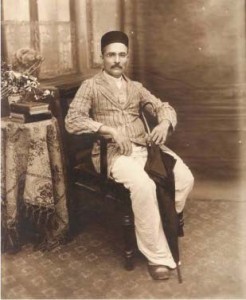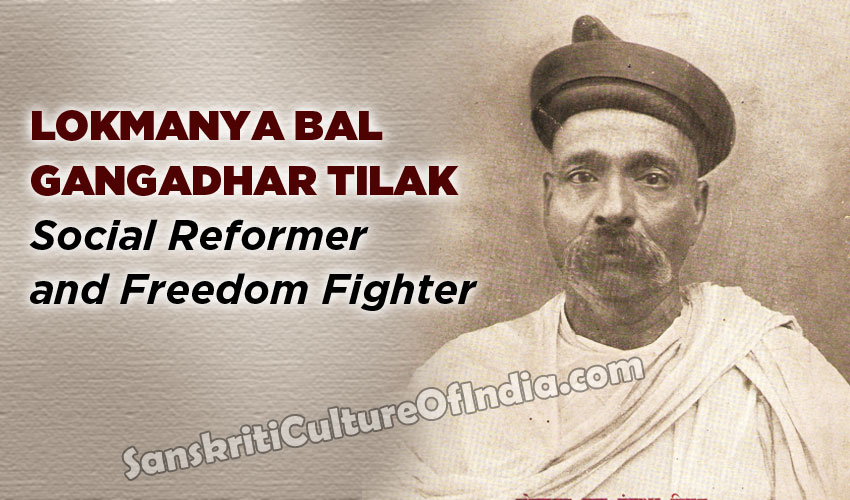Lokamanya Bal Gangadhar Tilak, the father of Indian Unrest a described by the British, inspired and mobilized millions of Indians through his powerful words and slogan, “Swaraj is my birthright and I shall have it”. He took Ganesh puja to spread a deep sense of patriotism among the masses through its nationalistic appeal. The great journalist-editor Tilak also started the celebration of Shivaji Festival on the Legendary Hero’s Birthday to symbolize hero worship in India. On the festival he wrote in his English newspaper Marhatta:
“Hero worship is a thing deeply implanted in human nature and our political aspirations need all the strength which the worship of an Indian hero is likely to inspire in our minds”.
 Bal Gangadhar Tilak was born in a middle class family of Ratnagiri, a small coastal town of Maharashtra on 23rd July 1856. He was brought up in an orthodox family and his father Gangadhar Pant was a strict disciplinarian, who infused in his son a love for learning. His father was a school teacher initially but rose to the position of School Inspector later. His mother had died when he was 10 years old. His father also died just after a few months of his marriage to Tapi, when he was 16. These circumstances made him fend for him for college education. After his matriculation, he joined the prestigious Deccan College of Pune and his B.A. in 1877, securing a first class in mathematics. He became a bachelor of Law two years later and began practice.
Bal Gangadhar Tilak was born in a middle class family of Ratnagiri, a small coastal town of Maharashtra on 23rd July 1856. He was brought up in an orthodox family and his father Gangadhar Pant was a strict disciplinarian, who infused in his son a love for learning. His father was a school teacher initially but rose to the position of School Inspector later. His mother had died when he was 10 years old. His father also died just after a few months of his marriage to Tapi, when he was 16. These circumstances made him fend for him for college education. After his matriculation, he joined the prestigious Deccan College of Pune and his B.A. in 1877, securing a first class in mathematics. He became a bachelor of Law two years later and began practice.
Right from his early age Tilak was convinced that the educational system the British provided for the Indians was not at all adequate, so he helped to found a school, named the New English School in 1880, which laid emphasis on nationalism. He also realized the state in which his motherland existed under the British rules and started two newspapers: – “Kesari” in Marathi and “Marahatta” in English, in 1881. Through these newspapers he informed the public about British policies, about his ideas of nationalism and the need to attain Swaraj. His views and writings commanded wide attention and esteem andhe became “Lokamanya” –the respected one.
British smelled treason in his words. His scathing articles like “Has the Government lost its Head?” and “To rule is not to wreak vengeance” appeared in Kesari” over inhuman punishment meted out to the nationalist youth during the unrest of partition of Bengal disturbed the British in 1905 and he was jailed after a namesake trail.
On the issue of partition of Bengal, Tilak rejected the moderate approach of Congress and jumped into the Vande Mahataram movement along with nationalist like Lala Lajpat Rai, Bipinchandra Pal and Aravinda Ghose. He Lunched the Nationalist Party in 1960 and started the Home-Rule League along with an Irish Lady, Ms. Annie Besant. He also started Swadeshi campaigns, organized a “paisa fund” to help develop Indian industry, picketed against foreign goods and arranged bonfires of foreign cloth as an expression of boycott. Foreign cloths become a symbol of exploitation of India because the British exported raw material from Indian and sold it back in the country a manufactured goods at a high rate. He realized that mere protest against British rule would not help anymore and instated on native production and self-reliance. So he told the masses: “we have no arms, but there is no necessity. But our strong political weapon is boycott. Organize your powers and then go to work so that they cannot refuse you what you demand”.
Instead of his conservative outlook towards social reforms he was a pioneer to foresee that mass support was needed to make his motherland free from imperialistic clutches. So without bothering about the Newspaper Act (amended), which empowered the authorities to confiscate any press and launch prosecution for any act of sedition, he boldly wrote articles to promote boycott and to demand independence. He was arrested on 24th June, 1908, on charge of inciting violence through his articles, “the countries misfortune” and “These remedies are not lasting “published in the “Kesari”. As the trail began Tilak advocated his own case and pleaded “not guilty” till the last. When the jury asked him to make his final statement before the sentence of exile was pronounced, Tilak said that, “all I wish to say that, in spite of the verdict of the jury, I maintain that I am innocent. There are higher powers that rule the destiny of man and nations and it may be the will of providence that the cause I represent may prosper more by my suffering than by my remaining free”.
The book “Geeta Rahasya”, a classic commentary of Bhagavad Geeta, the sacred book of Hindus was written by him in Marathi during his imprisonment at Mandalay. He stressed on his commentary that Geeta taught nothing but action (Karma) Religion and spiritual message were secondary and the need of the hour was to arise and Fight. This lord Krishna’s Message to Arjuna.
Tilak’s wife died at Pune while he was still in Mandalay prison of Burma and the news reached him only after a week. He felt distressed due to his absence at her death bed.
By the time Tilak completed his six year prison term, he became the unquestioned leader of the Indians – the uncrowned King. He was known as the Tilak Maharaj. There was unprecedented jubilation after his release and return to India. Civil resistance, the concept of Swaraj and nationalism had taken deep roots. His suffering bore fruit. A band of leaders full of zeal’s for nationalism and self-sacrifice was coming up. National schools were coming up in all corners of India. He paved the way for Khadi, picketing against the foreign goods and alcoholism. Mahatma Gandhi took the work after his death in 1920 and gave a concrete shape to his idea of Swadeshi.
He launched the Congress Democratic Party in 1920 but before he could take up the action he suddenly died on 1st of August. He had sacrificed his personal life, profession, name and fame for the sake of the country.
~ Prasad Morye










